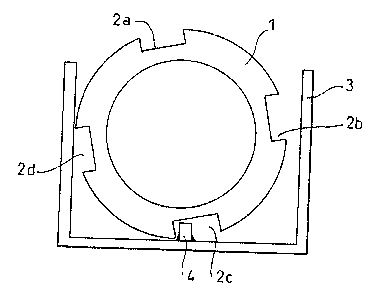Some of the information on this Web page has been provided by external sources. The Government of Canada is not responsible for the accuracy, reliability or currency of the information supplied by external sources. Users wishing to rely upon this information should consult directly with the source of the information. Content provided by external sources is not subject to official languages, privacy and accessibility requirements.
Any discrepancies in the text and image of the Claims and Abstract are due to differing posting times. Text of the Claims and Abstract are posted:
| (12) Patent: | (11) CA 2101597 |
|---|---|
| (54) English Title: | SAFETY DEVICE AGAINST RUPTURE OF A ROTARY SHAFT |
| (54) French Title: | DISPOSITIF DE PROTECTION CONTRE LE BRIS D'UN ARBRE TOURNANT |
| Status: | Expired and beyond the Period of Reversal |
| (51) International Patent Classification (IPC): |
|
|---|---|
| (72) Inventors : |
|
| (73) Owners : |
|
| (71) Applicants : |
|
| (74) Agent: | NORTON ROSE FULBRIGHT CANADA LLP/S.E.N.C.R.L., S.R.L. |
| (74) Associate agent: | |
| (45) Issued: | 2003-09-09 |
| (22) Filed Date: | 1993-07-29 |
| (41) Open to Public Inspection: | 1994-01-30 |
| Examination requested: | 2000-07-17 |
| Availability of licence: | N/A |
| Dedicated to the Public: | N/A |
| (25) Language of filing: | English |
| Patent Cooperation Treaty (PCT): | No |
|---|
| (30) Application Priority Data: | ||||||
|---|---|---|---|---|---|---|
|
A safety device against rupture of a rotary shaft
(1) for preventing the shaft from rotating and for
preventing broken portions thereof from falling, the
device being particularly suitable for use with a shaft
that winds up lifting straps for a raisable curtain or
that winds up the curtain itself, the device being
characterized in that at least one safety element (3, 5)
is placed to retain the shaft to prevent it from falling,
and in that the peripheral surface of the shaft and the
facing surface of said safety element are provided with
means such as portions in relief (2, 6) that co-operate
to prevent the shaft from rotating when a portion of the
shaft is retained by said safety element due to the shaft
rupturing.
Note: Claims are shown in the official language in which they were submitted.
Note: Descriptions are shown in the official language in which they were submitted.

2024-08-01:As part of the Next Generation Patents (NGP) transition, the Canadian Patents Database (CPD) now contains a more detailed Event History, which replicates the Event Log of our new back-office solution.
Please note that "Inactive:" events refers to events no longer in use in our new back-office solution.
For a clearer understanding of the status of the application/patent presented on this page, the site Disclaimer , as well as the definitions for Patent , Event History , Maintenance Fee and Payment History should be consulted.
| Description | Date |
|---|---|
| Time Limit for Reversal Expired | 2008-07-29 |
| Letter Sent | 2007-07-30 |
| Inactive: IPC from MCD | 2006-03-11 |
| Grant by Issuance | 2003-09-09 |
| Inactive: Cover page published | 2003-09-08 |
| Inactive: Inventor deleted | 2003-08-27 |
| Pre-grant | 2003-04-30 |
| Inactive: Final fee received | 2003-04-30 |
| Notice of Allowance is Issued | 2003-01-02 |
| Letter Sent | 2003-01-02 |
| Notice of Allowance is Issued | 2003-01-02 |
| Inactive: Approved for allowance (AFA) | 2002-12-23 |
| Amendment Received - Voluntary Amendment | 2002-11-13 |
| Letter Sent | 2002-09-19 |
| Reinstatement Requirements Deemed Compliant for All Abandonment Reasons | 2002-07-29 |
| Inactive: S.30(2) Rules - Examiner requisition | 2002-05-16 |
| Deemed Abandoned - Failure to Respond to Maintenance Fee Notice | 2001-07-30 |
| Inactive: Status info is complete as of Log entry date | 2000-07-27 |
| Letter Sent | 2000-07-27 |
| Inactive: Application prosecuted on TS as of Log entry date | 2000-07-27 |
| All Requirements for Examination Determined Compliant | 2000-07-17 |
| Request for Examination Requirements Determined Compliant | 2000-07-17 |
| Application Published (Open to Public Inspection) | 1994-01-30 |
| Abandonment Date | Reason | Reinstatement Date |
|---|---|---|
| 2001-07-30 |
The last payment was received on 2003-06-13
Note : If the full payment has not been received on or before the date indicated, a further fee may be required which may be one of the following
Please refer to the CIPO Patent Fees web page to see all current fee amounts.
| Fee Type | Anniversary Year | Due Date | Paid Date |
|---|---|---|---|
| MF (application, 4th anniv.) - small | 04 | 1997-07-29 | 1997-07-21 |
| MF (application, 5th anniv.) - small | 05 | 1998-07-29 | 1998-06-17 |
| MF (application, 6th anniv.) - small | 06 | 1999-07-29 | 1999-06-23 |
| MF (application, 7th anniv.) - small | 07 | 2000-07-31 | 2000-06-27 |
| Request for examination - small | 2000-07-17 | ||
| MF (application, 8th anniv.) - standard | 08 | 2001-07-30 | 2001-07-13 |
| MF (application, 9th anniv.) - standard | 09 | 2002-07-29 | 2002-07-10 |
| Reinstatement | 2002-07-29 | ||
| Final fee - standard | 2003-04-30 | ||
| MF (application, 10th anniv.) - standard | 10 | 2003-07-29 | 2003-06-13 |
| MF (patent, 11th anniv.) - standard | 2004-07-29 | 2004-06-16 | |
| MF (patent, 12th anniv.) - standard | 2005-07-29 | 2005-06-28 | |
| MF (patent, 13th anniv.) - standard | 2006-07-31 | 2006-06-22 |
Note: Records showing the ownership history in alphabetical order.
| Current Owners on Record |
|---|
| BERNARD KRAEUTLER |
| NERGECO (SOCIETE ANONYME) |
| Past Owners on Record |
|---|
| None |